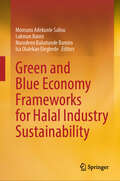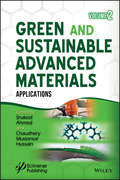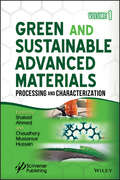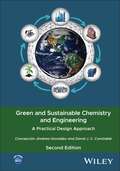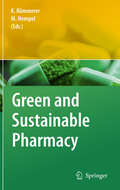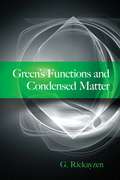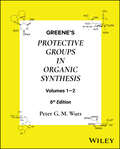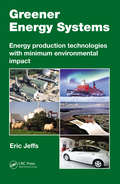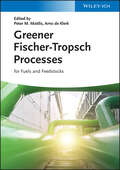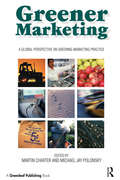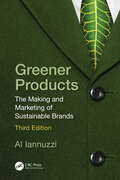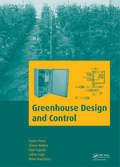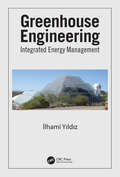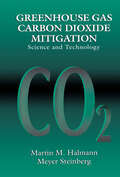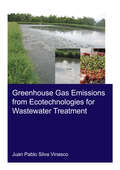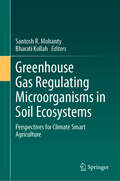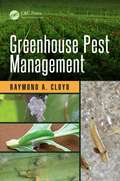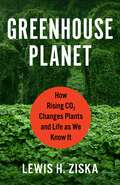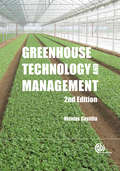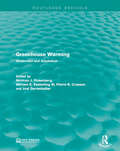- Table View
- List View
Green and Blue Economy Frameworks for Halal Industry Sustainability
by Lukman Raimi Monsuru Adekunle Salisu Nurudeen Babatunde Bamiro Isa Olalekan ElegbedeThis book serves as a valuable resource for economic policymakers, economic analysts, halal trainers, halal stakeholders, agribusiness advocates, and halal industry consultants in the rapidly changing emerging green and blue economy. The book explores the themes of green and blue economies for halal industry sustainability and business entrepreneurship as well as production and consumption, ethics and impact investments in halal, green and blue entrepreneurship, and principles governing the innovation of production framework through integration of green and blue economy. The green and blue economy frameworks can be applied to the Halal industry to enhance its sustainability and promote environmental and social responsibility. This book presents the emerging blue and green economy to halal entrepreneurs as a complementary alternative model for enterprise development, wealth creation, employment creation, responsible production, and sustainable consumption and a catalyst for attaining sustainable development goals.
Green and Sustainable Advanced Materials: Applications (Polymer Science And Technology Ser.)
by Shakeel Ahmed Chaudhery Mustansar HussainSustainable development is a very prevalent concept of modern society. This concept has appeared as a critical force in combining a special focus on development and growth by maintaining a balance of using human resources and the ecosystem in which we are living. The development of new and advanced materials is one of the powerful examples in establishing this concept. Green and sustainable advanced materials are the newly synthesized material or existing modified material having superior and special properties. These fulfil today’s growing demand for equipment, machines and devices with better quality for an extensive range of applications in various sectors such as paper, biomedical, textile, and much more. Volume 2, provides chapters on the valorization of green and sustainable advanced materials from a biomedical perspective as well as the applications in textile technology, optoelectronics, energy materials systems, and the food and agriculture industry.
Green and Sustainable Advanced Materials: Processing and Characterization (Polymer Science And Technology Ser.)
by Shakeel Ahmed Chaudhery Mustansar HussainSustainable development is a very prevalent concept of modern society. This concept has appeared as a critical force in combining a special focus on development and growth by maintaining a balance of using human resources and the ecosystem in which we are living. The development of new and advanced materials is one of the powerful examples in establishing this concept. Green and sustainable advanced materials are the newly synthesized material or existing modified material having superior and special properties. These fulfil today’s growing demand for equipment, machines and devices with better quality for an extensive range of applications in various sectors such as paper, biomedical, textile, and much more.Volume 1 gives overviews on a variety of topics of characterization of green and sustainable advanced materials including biopolymers, biocomposites, nanomaterials, polymeric materials, green functional textiles materials and hybrid materials, as well as processing chapters on the design and process aspects of nanofabrication.
Green and Sustainable Chemistry and Engineering: A Practical Design Approach
by Concepción Jiménez-González David J. ConstableThe first textbook to fully integrate Green and Sustainable Chemistry and Engineering, now in its second edition Green and Sustainable Chemistry and Engineering addresses key concepts and processes from an industrial and manufacturing perspective. Using an integrated, systems-oriented approach, this invaluable single-volume resource bridges the divide between chemistry, process design, and engineering, as well as environment, health, safety, and life cycle considerations. This revised new edition discusses trends in chemical processing that can lead to more sustainable practices, explores new methods in the design of greener chemical synthesis, addresses sustainability challenges and implementation issues, and more. Up-to-date examples and new practical exercises based on the broad experience of the authors in applied and fundamental research, corporate consulting, and education are incorporated throughout the text. Designed to advance green chemistry and green engineering as disciplines in the broader context of sustainability, Green and Sustainable Chemistry and Engineering: Illustrates the role of green and sustainable chemistry and engineering in the adoption of sustainable practices Describes the components of chemistry supporting the design of sustainable chemical reactions and reaction pathways Presents an approach to materials selection promoting the sustainability of chemical synthesis without diminishing efficiency Highlights key concepts that support the design of more sustainable chemical processes Provides background and context for placing a particular chemical process in the broader chemical enterprise Includes access to a companion website with a solutions manual and supplementary resources Green and Sustainable Chemistry and Engineering: A Practical Design Approach, Second Edition, remains an ideal textbook for graduate and senior-level courses in Chemistry and Chemical Engineering, and an invaluable reference for chemists and engineers in manufacturing and R&D, especially those working in fine chemicals and pharmaceuticals.
Green and Sustainable Pharmacy
by Maximilian Hempel Klaus KümmererWithin recent years pharmaceuticals have come into focus as contaminants of the environment (see for example Kümmerer, K. editor: Pharmaceuticals in the Environment). At the same time the issue of sustainable chemistry gained momentum. Bringing both together would result in sustainable pharmacy. Sustainable pharmacy is a totally new issue and approach. It addresses environmental, economical and social aspects of pharmacy. In the present stage the focus will be on environmental issues along the whole lifecycle of a pharmaceutical entity. That is dealing with resources and energy input but also with waste issues for example during the synthesis and production of an active pharmaceutical ingredient. Furthermore, it would also look on the compounds themselves and will aim to improve the degradability of the compounds after their use in the environment to reduce the environmental risk caused by pharmaceuticals in the environment. Another issue is the people using pharmaceuticals such as pharmacists, medical doctors and patients. How can they contribute to more efficient use of pharmaceuticals with less environmental burden and less risk for drinking water. The book "Sustainable Pharmacy" will address all these issues and will be the first one dealing with this important topic.
Green's Functions and Condensed Matter (Dover Books on Physics)
by G. RickayzenGreen's functions, named for the mathematician who developed them in the 1830s, possess applications in many areas of physics. This volume presents the basic theoretical formulation, followed by specific applications, and is suitable for advanced undergraduates, graduate students, and professionals in the area of condensed matter physics.Beginning with a description of Green's function in classical physics from a modern point of view, the text progresses to the definition and properties of Green's functions in quantum physics. Most of the book explores applications, focusing on transport coefficients of a metal, the Coulomb gas, Fermi liquids, electrons and phonons, superconductivity, superfluidity, and magnetism. The treatment assumes a good working knowledge of quantum mechanics and a familiarity with the occupation number representation. An appendix provides the main formulas and the correspondence with wave mechanics. Each chapter concludes with references and problems for further study.
Greene's Protective Groups in Organic Synthesis
by Theodora W. Greene Peter G. WutsThe Fourth Edition of Greene's Protective Groups in Organic Synthesis continues to be an indispensable reference for controlling the reactivity of the most common functional groups during a synthetic sequence. This new edition incorporates the significant developments in the field since publication of the third edition in 1998, including... New protective groups such as the fluorous family and the uniquely removable 2-methoxybenzenesulfonyl group for the protection of amines New techniques for the formation and cleavage of existing protective groups, with examples to illustrate each new technique Expanded coverage of the unexpected side reactions that occur with protective groups New chart covering the selective deprotection of silyl ethers 3,100 new references from the professional literatureThe content is organized around the functional group to be protected, and ranges from the simplest to the most complex and highly specialized protective groups.
Greene's Protective Groups in Organic Synthesis
by Peter G. WutsAn indispensable reference for any practicing synthetic organic or medicinal chemist, this book continues the tradition of Greene's as comprehensive in the overall scope of coverage, providing the most relevant and useful examples to illustrate each methodology. * Presents valuable material, on the application of protective groups in organic chemistry, that is not easily found by casual searching * Helps chemists to plan, investigate, and carry out organic syntheses in an efficient manner * Adds over 2800 new references to update since the publication of the last edition * Reviews of the prior edition: "An essential bible for the library or personal bookshelf of chemists performing complex synthesis." (CHOICE, May 2007) "...the most up-to-date compilation available...should be an integral part of all institutional libraries...it is also highly recommended that individuals...maintain their own copy..." (Journal of Medicinal Chemistry, March 8, 2007) "...continues to be a comprehensive guide to the techniques for the formation and cleavage of protective groups." (Journal of the American Chemical Society, January 31, 2007)
Greene's Protective Groups in Organic Synthesis
by Peter G. WutsIntegral, reliable, and comprehensive guidance for chemists performing the complex syntheses required for the formation and cleavage of protective groups Organic synthesis is the preparation and creation of organic compounds for use in natural products, pharmaceuticals, and other molecules. The synthesis of molecules having multiple functional groups often requires the use of ‘protective groups’ to achieve site selectivity in a chemical reaction within a molecule bearing multiple sites of reactivity. Protective groups are installed temporarily to prevent unwanted reactions at a particular site, while transforming a different functional group. Once they have served their function, they are removed to expose the original group. Without a thorough understanding of the methods required to install and remove them, the design of a synthesis of a molecule having multiple functional groups in most cases is effectively impossible. Greene’s Protective Groups in Organic Synthesis, 6th Edition is the definitive compilation of protective groups, their classification, and their application in a wide array of situations. With a long tradition of comprehensive coverage, organized on the basis of the functional group in need of protection and subsequent deprotection, it is an essential reference and resource for all chemists involved in organic syntheses. Now fully updated to reflect the current state of the art, it remains an indispensable resource for generating life-changing organic products. This edition contains a new chapter on how protective groups effect reactivity and selectivity in carbohydrate chemistry. Readers of the sixth edition of Greene’s Protective Groups in Organic Synthesis will also find: Methodology for planning selectivity in organic synthesesDetailed discussion of all major functional groups including ethers, amides, and phenolsA discussion of the impact of protective groups on reactivity in carbohydrates Greene’s Protective Groups in Organic Synthesis is ideal for synthetic organic chemists or medicinal chemists in academia, industry — pharmaceuticals, food, agrochemicals, and biotech — or government agencies.
Greener Energy Systems: Energy Production Technologies with Minimum Environmental Impact
by Eric JeffsRecent years have seen acceleration in the development of cleaner energy systems. In Europe and North America, many old coal-fired power plants will be shut down in the next few years and will likely be replaced by combined cycle plants with higher-efficiency gas turbines that can start up and load quickly. With the revival of nuclear energy, designers are creating smaller nuclear reactors of a simpler integrated design that could expand the application of clean, emission-free energy to industry. And a number of manufacturers now offer hybrid cars with an electric motor and a gasoline engine to charge the batteries on the move. This would seem to be the way forward in reducing transport emissions, until countries develop stronger electricity supply systems to cope with millions of electric cars being charged daily. Greener Energy Systems: Energy Production Technologies with Minimum Environmental Impact tackles the question of how to generate enough electricity, efficiently and with minimum environmental impact, to meet future energy needs across the world. Supplemented with extensive figures and color photographs, this book: Traces the development of electricity supply Explains energy production risks and how major accidents have influenced development Discusses the combined cycle, the preferred system for power capacity expansion in much of the world Looks at combined heat and power Addresses whether coal can continue to be a fuel for power generation Examines nuclear power generation Asks why shipping has not followed some of the world's navies into nuclear propulsion Considers how to electrify more transport systems Reviews the current state of renewable systems, particularly hydro and solar The book defines the key elements of greener energy systems, noting that they must be highly efficient, with rapid start up and loading; produce minimum emissions; and use simpler technology. The author has more than forty years of experience as an international journalist reporting on power-generation technologies and energy policies around the world. He concludes that there is no place for coal and that combined cycle, hydro, solar, and biomass must complement nuclear energy, which must serve more applications than just generating electricity.
Greener Fischer-Tropsch Processes for Fuels and Feedstocks
by Arno De Klerk Peter M. MaitlisHow can we use our carbon-based resources in the most responsible manner? How can we most efficiently transform natural gas, coal, or biomass into diesel, jet fuel or gasoline to drive our machines? The Big Questions today are energyrelated, and the Fischer-Tropsch process provides industrially tested solutions.This book offers a comprehensive and up-to-date overview of the Fischer-Tropsch process, from the basic science and engineering to commercial issues. It covers industrial, economic, environmental, and fundamental aspects, with a specific focus on 'green' concepts such as sustainability, process improvement, waste-reduction, and environmental care. The result is a practical reference for researchers, engineers, and financial analysts working in the energy sector, who are interested in carbon conversion, fuel processing or synthetic fuel technologies. It is also an ideal introductory book on the Fischer-Tropsch process for graduate courses in chemistry and chemical engineering.
Greener Marketing: A Global Perspective on Greening Marketing Practice
by Martin Charter Michael Jay PolonskyBuilding on the strengths of the material published in the hugely successful first edition of Greener Marketing, this important new title examines on a global scale the progress of environmental marketing in the 1990s and considers how social issues are increasingly becoming critical factors in how corporations meet the ever-growing demands and expectations of customers. Despite the fact that such issues are increasingly important in marketing activities around the world, it is difficult for practitioners to keep up to date with complex and rapidly changing information and ideas. The purpose of this book is to provide practitioners and academics with best-practice examples and actionable recommendations on how to implement and appraise green marketing activities. It will provide information and ideas for those involved in marketing on how to incorporate environmental and social considerations, as well as providing new perspectives on marketing for environmental managers. To achieve a comprehensive viewpoint, the book is split into three sections. The first sets out the strategic issues and rationale for green marketing, the second addresses tactical issues in more detail, and the third provides detailed international case studies. Topics addressed by the global set of contributors include the growing area of products versus services, environmental product development, green marketing alliances, environmental communications, green consumers, eco-tourism and environmental marketing in developing countries. reener Marketing is not only a sequel to the successful first volume, but redefines global progress towards the successful marketing of greener products and services.
Greener Products: The Making and Marketing of Sustainable Brands
by Al IannuzziSustainability and its competitive advantage are the goals of every company and any brand that wants to stay successful in the marketplace. Customers also gravitate to brands that manage sustainability issues well. Greener Products: The Making and Marketing of Sustainable Brands written by a renowned sustainability expert, continues to address the latest developments in the extremely fast-moving field of sustainability. The third edition is thoroughly updated, introduces new case studies, and includes a new chapter on green marketing. With over 40 case studies, it explores the best practices of leading global companies and helps readers learn what it is that makes them successful.New in the Third Edition: Presents, in a practical way, the best practices of sustainable brands in a global economy. Addresses the most current sustainability topics like circular economy, plastics in the environment, biodiversity, climate change, green chemistry, etc. Includes current marketing information on consumer trends to purchase greener products. Incorporates the latest pressures on companies to address sustainability, retailer programs, business-to-business expectations, ESG raters, rankers, and stock funds. Covers best practices of companies from various industries on how to make and market greener products. Provides current tools for making products more sustainable and methods on how to market sustainable improvements. Includes lecture slides available upon request for use in the classroom. This book serves senior undergraduate and graduate students in programs focused on sustainability, as well as academics and corporate sustainability leaders. The previous versions have been used to teach courses on sustainability, product improvement, introduction to sustainability, green marketing and sustainability, and sustainability policy. Any university that teaches a course on sustainability and any company or individual interested in making and marketing more sustainable products would benefit from the new edition of this book.
Greener Synthesis of Organic Compounds
by Ahindra NagThis book provides an interdisciplinary, integrative overview of environmental problem-solving using mild reaction conditions, green reagents, waste free and energy efficient synthesis in both industry and academic world. Discussions include a broad, integrated perspective on sustainability, integrated risk, multi-scale changes and impacts taking place within ecosystems worldwide. Features: This book serves as a reference book for scientific investigators who need to do greener synthesis of organic compounds, drugs and natural products under mild reaction condition using green reagents, eco-friendly catalysts and benign reaction mediums over traditional synthetic processes which is a key driving force of scientists. Greener synthesis of multiple value-added heterocycles opens up a new horizon towards the organic catalysis and for this purpose, development of natural resources acts as an effective catalyst. Using environmentally friendly reaction medium e.g. ACC, WETSA, WEBSA have been used for the synthesis of some crucial heterocyclic scaffolds such as bisenols and 2-amino-4H-pyrans, tetraketones, pyrans, and biaryls. This book can also be used as a textbook for graduate and post graduate level courses for students. Furthermore, the problems with answers in book will add better understanding for students.
Greenhouse Design and Control
by Arturo Molina Pedro Ponce Brian MacCleery Paul Cepeda Esther LugoThis book deals with different types of greenhouses, materials, structures, advanced control techniques and tendencies that are needed for designing and controlling an advanced greenhouse. The control system is presented as an integral system which covers the explanation of basic and advanced concepts for a real time controller. Also, structural analysis is introduced, whereby mechanical design is regarded as a key factor. The book incorporates simulations and experimental results, and utilizes LabVIEW and ADAMS software. Finally, it provides a perspective on the present state and future of greenhouses globally.
Greenhouse Engineering: Integrated Energy Management
by Ilhami YildizSustainable energy development concept requires and maintains multiple linkages among energy production, energy consumption, human well-being, and environmental quality. Greenhouse Engineering: Integrated Energy Management puts forward the concept of integrated energy management and modeling pertinent to greenhouses that will eventually help reduce the load on power grids, demand for fossil fuels and water, and supply CO2 for the greenhouse production. This book helps enhance the competitive position of the global greenhouse industry by introducing economically, environmentally and socially sustainable technologies and management strategies. Exclusive title on integrated energy management approach for greenhouse designing Addresses energy for heating concept Includes case studies from real work greenhouse systems Incorporates a design/energy management approach Contains updated material on greenhouse heating with examples and case studies Aimed at researchers, professionals, and students in the fields of energy systems, mechanical, agriculture, and biosystems engineering.
Greenhouse Gas Carbon Dioxide Mitigation: Science and Technology
by Martin M. Halmann Meyer SteinbergAny mention of the "greenhouse effect" tends to ignite controversy. While the rising atmospheric concentrations of greenhouse gases-especially carbon dioxide- are certainly among the most pressing issues today, theoretical and perceived consequences have been subject to conjecture and misinformation. That raging debate has obscured an important
Greenhouse Gas Emissions from Ecotechnologies for Wastewater Treatment
by Juan Pablo Silva VinascoEcotechnologies for wastewater treatment (EWWT) have been used as a cost-effective alternative to conventional wastewater treatment methods for improving the removal of organic carbon, nutrients and pathogenic microorganisms from wastewater. However, due to biochemical transformations of organic matter and nutrients EWWT are net sources of CO2, CH4 and N2O greenhouse gases (GHGs), which may be transferred into the atmosphere contributing to global warming. Greenhouse Gas Emissions from Ecotechnologies for Wastewater Treatment provides scientific information about greenhouse gas, such as CO2, CH4 and N2O, generation and emissions from different municipal EWWT. The main EWWT considered in this book are anaerobic ponds, facultative ponds, duckweed-based ponds, and a freshwater natural wetland perturbed by anthropogenic activities such as wastewater discharge and nutrients from agricultural run-off. The book includes a full literature review of recent publications about GHGs emissions from EWWT. It also introduces the calculation of GHGs flux using a static chamber technique. Besides, the book presents information on the influence of environmental factors such as temperature, pH, DO, and nutrients on GHG emissions produced in EWWT under tropical conditions. This book will be a useful reference for researches and students interested in the broader area of water and climate change subjects. The publication may also be of interest to policy makers concerned with climate change, water sector planning, and wastewater treatment.
Greenhouse Gas Emissions: Challenges, Technologies and Solutions (Energy, Environment, and Sustainability)
by Avinash Kumar Agarwal Narasinha Shurpali Vk SrivastavaThis book covers the exchange of greenhouse gases in various ecosystems, biomes and climatic zones, and discusses the measurement, modelling and processes involved in these exchange dynamics. It reflects the growing body of knowledge on the characterization, feedback processes and interaction of greenhouse gases with ecosystems and the impact of human activities. Offering a compilation of selected case studies prepared by international researchers working in the field, it represents a valuable resource for researchers and students alike.
Greenhouse Gas Regulating Microorganisms in Soil Ecosystems: Perspectives for Climate Smart Agriculture
by Santosh R. Mohanty Bharati KollahThis volume comprehensively covers soil microbial processes that regulate the flux of greenhouse gasses (GHG) from agricultural soils, in an effort to address how GHG regulating microbes can be used to mitigate harmful climate change impacts on agriculture. The chapters define the linkages among soil microbial functioning, crop responses, ecosystem functioning, and GHG cycling processes. The book is framed through three major theme, including source and sink of GHG, microbial processes regulating GHG, and agricultural strategies and technologies to mitigate GHG emissions. The chapters highlight the fundamentals of soil microbial diversity and interactions with climate changing factors, soil carbon dynamics in response to different agricultural practices, conservation agriculture strategies to reduce GHG emissions from agriculture, and climate change mitigation through organic and climate-smart farming. The book is intended for policy makers, students, and researchers of environmental science, agriculture, soil science, and soil microbiology.
Greenhouse Gases: Sources, Sinks and Mitigation
by Pallavi Saxena Saurabh SonwaniThis book begins with a brief background on greenhouse gases sources and sinks and continues with a discussion in different sectors including forest fluxes to human health and modeling techniques to policy measures. The chapters explore in detail about the GHG emission budgets, mitigation strategies, technical advancement and input-output analysis. Greenhouse gases (GHGs) occur naturally in our atmosphere and are essential to the survival of most of the organisms on the planet earth. GHGs such as such as carbon dioxide, methane, nitrous oxide, and ozone etc. play a major role in balancing the radiative budget, by absorbing or emitting some of the infrared rays reflecting from the earth’s surface. But unfortunately, anthropogenic activities like use of fossil fuel, intensive agriculture and livestock farming, use of synthetic fertilizers, deforestation, and industrial processes etc. have drastically interfered in the natural air composition, by releasing excess greenhouse gases into the atmosphere. This has led to the increase in the ability of the atmosphere to absorb more infrared energy. This book is a complete information set covering all aspects of GHGs, sources, sinks and control/mitigation strategies. This book is also written in simple language with helpful photographs, diagrams and flowcharts which will make the reader comfortable in understanding the concepts a more relatively easier way. The book is a valuable tool for students in Environmental Science, Ecology, Biological Science, Economics and Agriculture. It is unique to environmental consultants, researchers and other professionals involved in climate change studies, Non-governmental organizations (NGO’s).
Greenhouse Pest Management (Contemporary Topics in Entomology)
by Raymond A. CloydAs the sustainable agriculture movement has grown, there has been a dramatic increase in the production of horticultural crops in greenhouses worldwide. Although there are numerous publications associated with pest management in greenhouses, Greenhouse Pest Management is the first comprehensive book on managing greenhouse arthropod pests, particula
Greenhouse Planet: How Rising CO2 Changes Plants and Life as We Know It
by Lewis H. ZiskaThe carbon dioxide that industrial civilization spews into the atmosphere has dramatic consequences for life on Earth that extend beyond climate change. CO2 levels directly affect plant growth, in turn affecting any kind of life that depends on plants—in other words, everything.Greenhouse Planet reveals the stakes of increased CO2 for plants, people, and ecosystems—from crop yields to seasonal allergies and from wildfires to biodiversity. The veteran plant biologist Lewis H. Ziska describes the importance of plants for food, medicine, and culture and explores the complex ways higher CO2 concentrations alter the systems on which humanity relies. He explains the science of how increased CO2 affects various plant species and addresses the politicization and disinformation surrounding these facts.Ziska confronts the claim that “CO2 is plant food,” a longtime conservative talking point. While not exactly false, it is deeply misleading. CO2 doesn’t just make “good” plants grow; it makes all plants grow. It makes poison ivy more poisonous, kudzu more prolific, cheatgrass more flammable. CO2 stimulates some species more than others: weeds fare particularly well and become harder to control. Many crops grow more abundantly but also become less nutritious. And the further effects of climate change will be formidable.Detailing essential science with wit and panache, Greenhouse Planet is an indispensable book for all readers interested in the ripple effects of increasing CO2.
Greenhouse Technology and Management
by Nicolas Castilla Esteban BaezaGreenhouse cultivation has expanded in recent decades with increased demand for horticultural production. This book covers current technologies and management practices of general greenhouse production, with a particular emphasis on plastic greenhouses and vegetable growing. The author begins by addressing the natural greenhouse microclimate, in the context of managing greenhouse systems such as ventilation, cooling, heating, carbon dioxide enrichment, light management, crop physiology, greenhouse design and construction criteria. The book then moves on to cover other issues of greenhouse management including irrigation and fertilization, soil and substrate cultivation, plant protection, regulation, economic analysis, environmental impact, and post-harvest, production strategies and marketing. Providing an integrated approach to greenhouse production this practical text aims to provide clear advice on optimising the yield and quality of crops grown under greenhouse conditions.
Greenhouse Warming: Abatement and Adaptation (Routledge Revivals)
by Joel Darmstadter Norman J. Rosenberg William E. Easterling III Pierre R. CrossonOriginally published in 1989, Greenhouse Warming combines papers presented at a workshop held in 1987 to discuss climate change. This study identifies ways that climate impacts upon agriculture, forestry and water resources in order to advise on safeguarding against drought, flood and extreme cold as well as what policies can be implemented to adapt to the probable physical and socioeconomic impacts of climate change. This study will be of interest to students of environmental studies.
